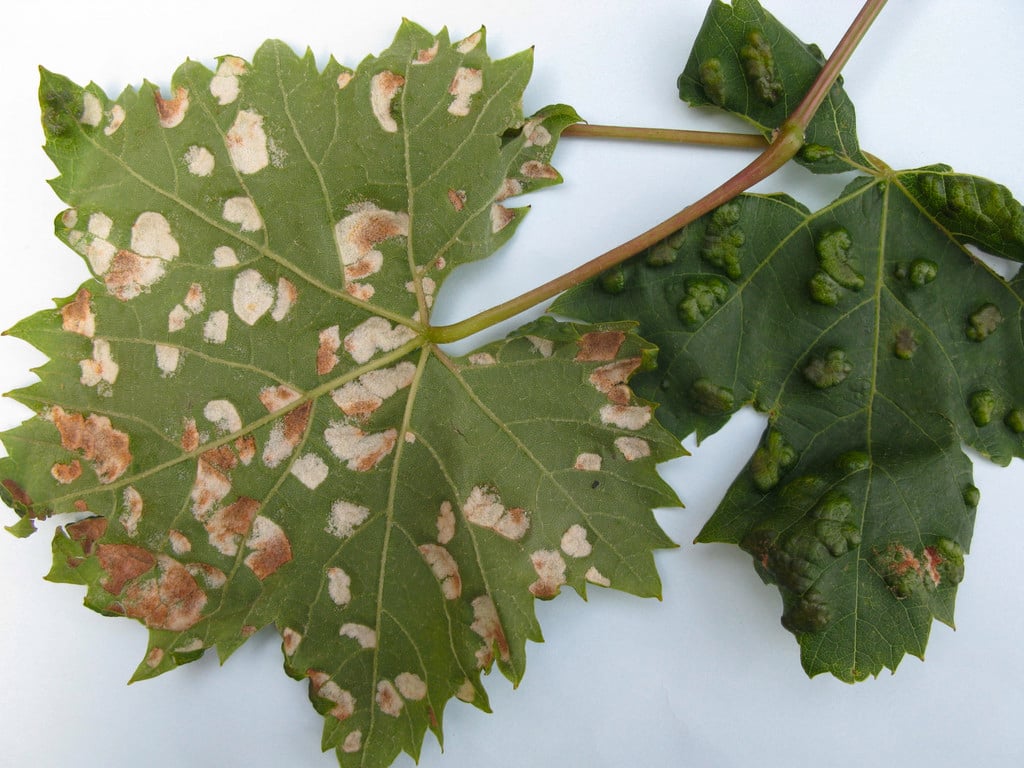Grapevine blister mite
During the summer foliage of grape vines can become distorted and the underside of leaves covered with a dense coating of fine hairs caused by the feeding activities of a gall mite. This does not affect the health of the vine.

Quick facts
Scientific name Colomerus vitis
Plants affected Grape vine
Main cause A microscopic gall mite
Timing May-September
What is grapevine blister mite?
Grape vine blister mite is a type of eriophyid gall mite. These gall mites are tiny (less than 0.2 mm) sap-sucking creatures that cause a variety of abnormal growths on various plants, they are white, sausage shaped, and unlike most arachnids only have two pairs of legs. Although the mites are too small to be seen without a microscope, the galled tissues that they create are often very distinctive and easily recognised. The excessive growth of hairs on the underside of leaves caused by some gall mites, including grapevine blister (or erinose) mite Colomerus vitis, is called a felt gall or erineum.
There are many species of eriophyid mite which are usually host specific this means that each species of mite will only feed on a single, or several closely related, plant species. Eriophyid mites feed by sucking sap but while doing so secrete chemicals into the plant tissue that converts some of the normal (parenchyma) plant cells to meristem tissues which can give rise to a range of growth forms. These then grow to produce the gall. The mites can then suck sap from plant cells lining the gall structure, which are invariably more nutritious than unaffected tissue, but often do not cause serious damage to the plant.
Symptoms
Symptoms begin to appear in late spring. The upper surface of affected leaves bulges upwards, giving the leaves a puckered appearance. Beneath the raised areas, a dense coating of short fine hairs develops, amongst which the mites live and feed. The hairs are usually creamy white but on some grape cultivars, may be pinkish red. In late summer the hairs start to dry up and can become brownish.
While the mites are sucking sap, they secrete chemicals into the foliage that induces the abnormal growth. The hairy covering on the underside of the leaves could be mistaken for a fungal disease, such as mildew, but the mite is a not a problem. It does not affect the fruit and does not seem to have any harmful effect, apart from distorting the leaves.
Management
The mite should be tolerated as it will not affect fruiting or health of grape vines.
If the mite cannot be tolerated and only a few leaves or shoots are affected by galling, these can be cut off and disposed of. If many leaves are affected, the presence of the mite should be tolerated, as removing affected leaves will cause more damage than the mite.
Biology
Grape vine blister mites overwinter on the grape vine by hiding away beneath bud scales. The mites emerge in spring and begin feeding on the new foliage. Several generations develop in the underside of the leaves during the summer. In late summer, the matted hairs created by the gall mites begin to dry up and this causes the mites to leave the foliage and seek places where they can overwinter.
Get involved
The Royal Horticultural Society is the UK’s leading gardening charity. We aim to enrich everyone’s life through plants, and make the UK a greener and more beautiful place.